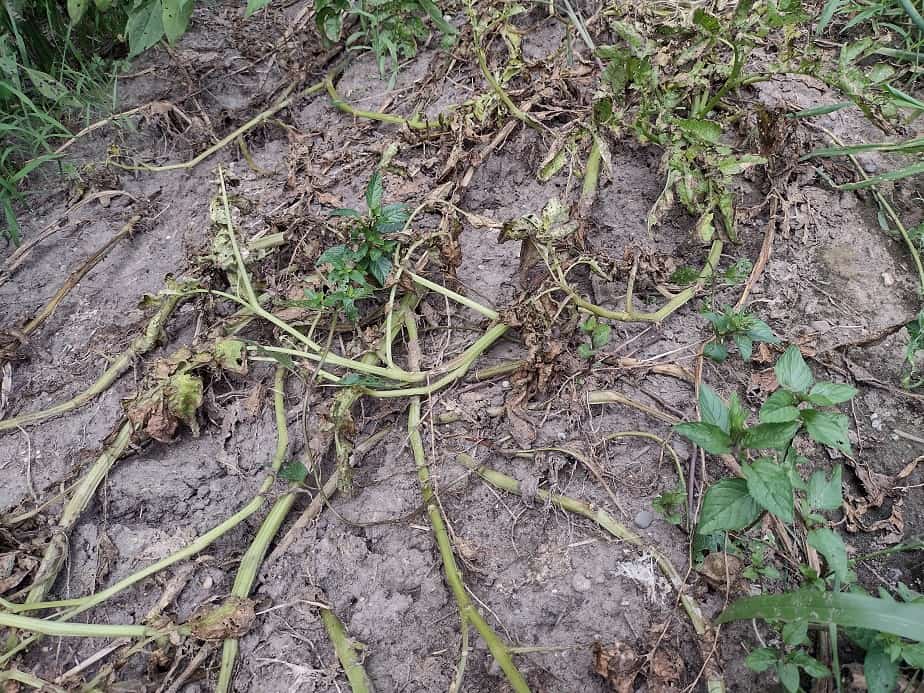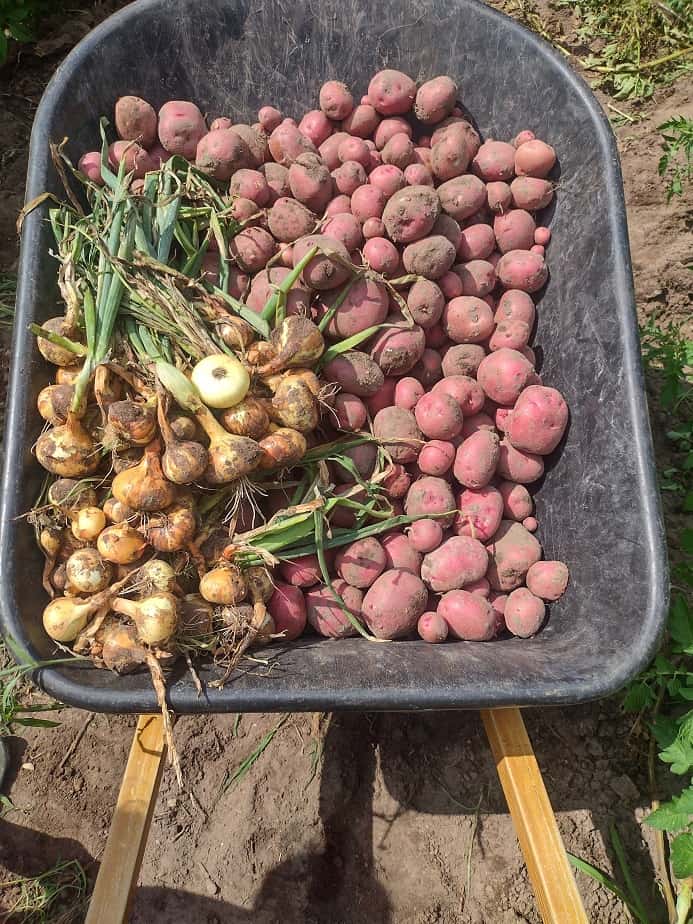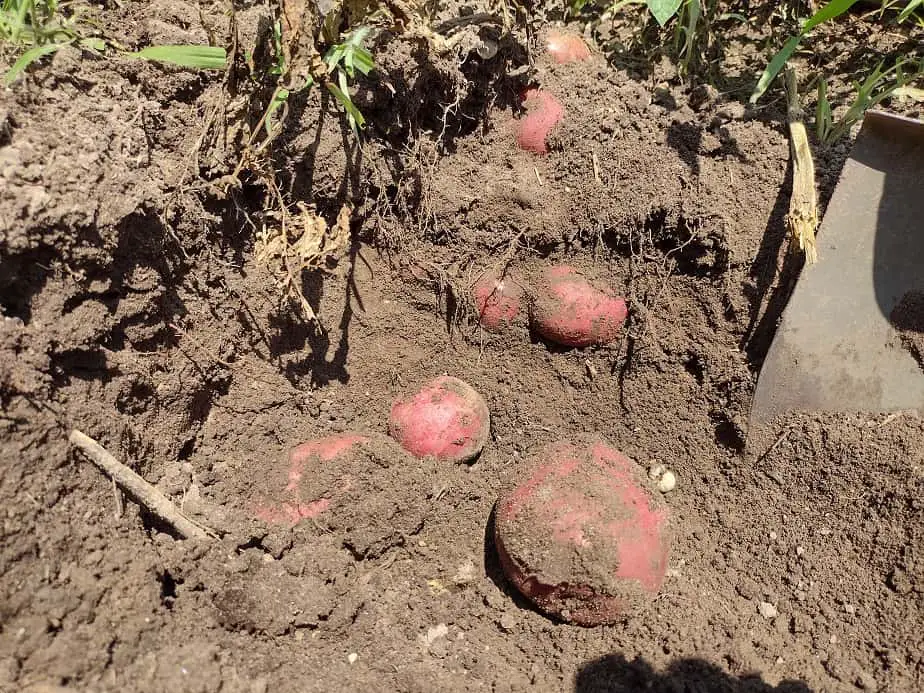Potatoes are perhaps the most filling crop grown in the Wolverine state. We’ll be digging up several hundred pounds of Kennebec and Red Norland spuds this week to begin filling the pantry.
Potatoes can be planted in Michigan whenever the ground isn’t frozen. Most growers plant them between March and May for a mid to late summer harvest. Early planting is often done in February-March for an early summer harvest. Planting late fall, the Irish method, will give you a late spring harvest.
Planting A Crop of Potatoes in Michigan.
Before you plant potatoes, you need to get the soil ready. Potatoes thrive in carbon-rich black soil with a loose, fluffy texture. When the soil is ready, you have to get the shovel and dig. Potatoes are commonly planted 1-foot apart in rows with 2 feet between each row.
Planting closer than 12 inches will result in root overcrowding, which stunts the plants. Planting rows further than 2 feet apart allows sunlight to bake the soil, causing potato plants to stop increasing tuber size. If your soil fertility is poor, you can go with 3 feet, but it may lessen the harvest considerably.
Potatoes are my favorite high-calorie crop to grow on our homestead. They love our cool summer evenings, long days, and cold spring/fall weather. That’s why they grow so good here. The cool weather encourages not only big potatoes but also healthier plants overall. Here are my planting methods.

Planting Early Potatoes in Michigan
Plant potatoes February-March, when the soil first thaws, even if it’s going to freeze again. Remove any snow and dig a 12-inch deep hole or trench to be sure the soil is thawed out all the way. As long as the hole doesn’t begin to fill with water, it’s time to plant.
Mark out rows in your planting area. I use tall wooden stakes and rope to mark out one row at a time. Dig a trench 9-inches deep along the rope and place 3 inches of straw or in the hole. Tamp the straw down a little with a boot or the back of a hoe. Put the prepared seed potatoes in the center, one every foot.
Sprinkle on some compost, then a little more straw. Cover with a few inches of soil, a little straw, then more dirt to fill the trench. Spread more straw on top 4 to 6 inches deep for insulation against freezing. If there’s a lot of snow, you can shovel some back because it will actually help the soil not freeze.
The straw on the bottom helps drainage, which can be an issue in early spring. The compost boost microorganism activity which both deeds the soil and keeps it a bit warmer. The other straw is insulation. and will create a little heat as microbes break it down. It’s a freeze-proof, soil-enriching technique.
Usually, I see potato plants coming up a month after the snow melt, which is earlier than almost anything, even most weeds. As long as the soil was prepped well beforehand and you keep the bugs out, you can expect 4-7 pounds of potatoes per plant.
Planting Potatoes in the Fall
Plant potatoes in November, before the ground freezes, and cover them with 10-inches of leaves or straw to keep them warm. Fall-planted potatoes can be ready to harvest in June, 2 months before most gardeners can harvest potatoes.
This is a traditional Irish method of planting potatoes that works well in Michigan, except for the areas that get into USDA Zone 4. It can be hard to keep them from freezing there. In a given year, I may lose up to 20 percent of my fall-planted potatoes to freeze and spring rot, but I can still get a decent crop early.
A friend of mine wrote a great article on when to harvest potatoes by variety. Here’s a link to it

Prepping the Ground For Potatoes
Potatoes need high fertility, well-drained soil and prefer a high-organic content soil. First off, select an area that will not pool water or flood in a rainy spring. Next, you need to boost up the organic matter using compost, manure, or other compostable material. Pile it high.
Don’t feel like you need to till it in. It’s actually better not to. When you dig trenches to plant the potatoes it will mix well enough. Potatoes need a lot of Nitrogen. I usually fertilize with manure and add Urea for nitrogen if I need to. Manure is usually very low in nitrogen.
Just before planting, You’ll need to test your soil to determine how fertile it actually is. The only soil test kit I use is the LusterLeaf 1601. It’s cheap and the easiest to read. If you have nitrogen, phosphorus, and potassium in the mid-range, you’re good for now. If not, add some fertility.
You can use a basic garden fertilizer like a 10-10-10, but that’s not the best mix. I mix my own basically emulating the classic Miracle-Grow, a much better formulation. Approximately 3 pounds of 10-10-10 or 1.5 pounds of 20-20-20 per 100 square feet/ 100 plants will bring it up to the halfway point if it’s depleted.
That comes out to a level tablespoon of 10-10-10 or a rounded teaspoon of 20-20-20 per plant.
Test the soil again after a month and see how it’s doing. Fertility can leach away quickly, especially in soil with low organic matter. If you need more fertility, do it again. by the time the plants start poking out, you want the soil to show at least in the mid-range, “ADEQUATE” on that specific soil test kit.
3-4 weeks after emergence, test your soil to see if it needs more fertility. At this point, You would want it to show above “ADEQUATE”. If not, re-apply the 3 pounds of 10-10-10 or 1.5 pounds of 20-20-20 per 100 square feet/ 100 plants. Apply it evenly in a line down the row.
One of my favorite prepping techniques to use the fall before is to fill the area with straw, fallen leaves, and/or grass clippings, then go over that spot with my chicken tractor. Oftentimes, that gives me all the nitrogen I need.
Related articles:

